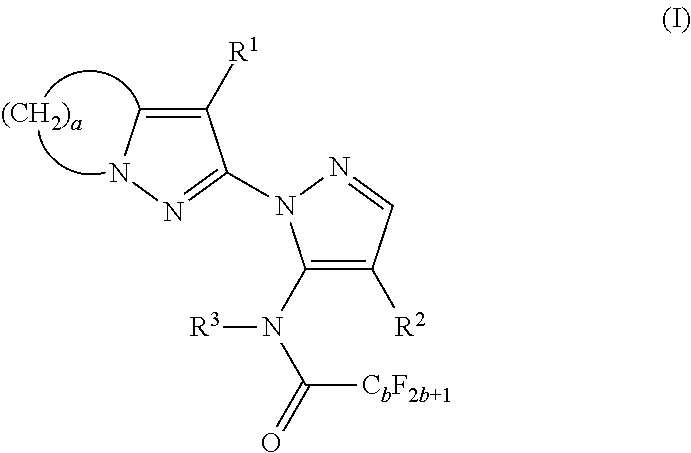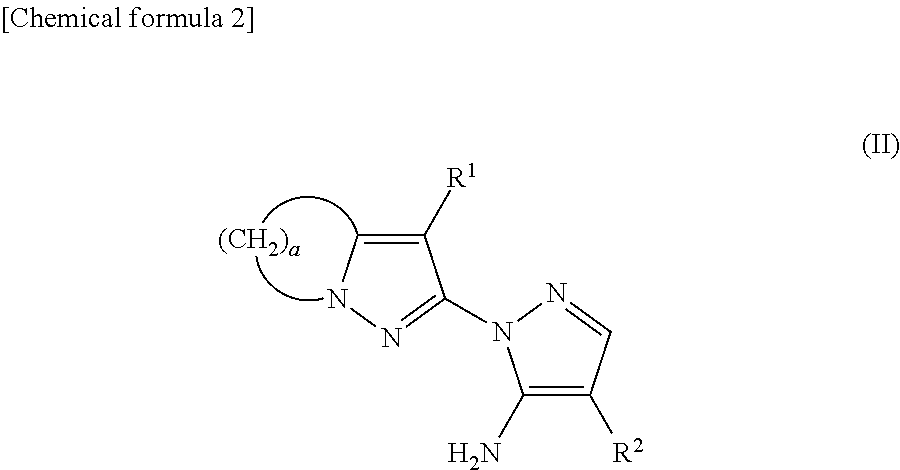Substituted pyrazolylpyrazole derivative and use of same as herbicide
a technology of pyrazolylpyrazole and derivative, which is applied in the field of substituting pyrazolylpyrazole derivative, can solve the problems of difficult to control paddy weeds, difficult to control all weeds with a single spray of herbicide, and prolong the growth of perennial weeds, etc., and achieves superior herbicidal efficacy, wide herbicidal spectrum, and wide herbicidal spectrum.
- Summary
- Abstract
- Description
- Claims
- Application Information
AI Technical Summary
Benefits of technology
Problems solved by technology
Method used
Image
Examples
example 1
Method for the Synthesis of N-(2-chloroethyl)-N-(1-(3-chloro-4,5,6,7-tetrahydropyrazolo[1,5-a]pyridin-2-yl)-4-cyanopyrazol-5-yl)-2,2,2-trifluoroacetamide (Compound 1)
[0055]Formic acid (18.4 g) was slowly dropped into acetic anhydride (33.7 g) cooled to 5° C. followed by stirring for 2 hours at 60° C. (Reaction Mixture A). Separate from the above, 5-amino-1-(3-chloro-4,5,6,7-tetrahydropyrazolo[1,5-a]pyridin-2-yl)pyrazole-4-carbonitrile (26.3 g) was dissolved in acetonitrile (200 ml) and stirred. The previously prepared Reaction Mixture A was slowly dropped therein and reacted for 1 day at room temperature and then for 4 hours at 60° C. Subsequently, the solvent was distilled off under reduced pressure followed by neutralizing using aqueous potassium carbonate solution, washing the precipitated solid with water and drying to obtain N-(1-(3-chloro-4,5,6,7-tetrahydropyrazolo[1,5-a]pyridin-2-yl)-4-cyanopyrazol-5-yl)formamide (28 g).
[0056]N-(1-(3-chloro-4,5,6,7-tetrahydropyrazolo[1,5-a]py...
example 2
Method for the Synthesis of N-(1-(3-chloro-4,5,6,7-tetrahydropyrazolo[1,5-a]pyridin-2-yl)-4-cyanopyrazol-5-yl)-N-(2-methoxyethyl)-2,2,2-trifluoroacetamide (Compound 2)
[0059]5-amino-1-(3-chloro-4,5,6,7-tetrahydropyrazolo[1,5-a]pyridin-2-yl)pyrazole-4-carbonitrile (43.1 g) was dissolved in N,N-dimethylformamide (170 ml) followed by the addition of 55% sodium hydride (8.6 g) and stirring. After confirming that foaming had subsided, 2-bromoethyl methyl ether (25 g) was slowly dropped in while cooling the reaction mixture with an ice bath followed by reacting for 8 hours at 60° C. following completion of dropping. Following completion of the reaction, water was added to the reaction mixture and the precipitated solid was washed with ethyl acetate to obtain 1-(3-chloro-4,5,6,7-tetrahydropyrazolo[1,5-a]pyridin-2-yl)-5-(2-methoxyethylamino)pyrazole-4-carbonitrile (36 g).
[0060]Acetonitrile (65 ml) was added to the resulting 1-(3-chloro-4,5,6,7-tetrahydropyrazolo[1,5-a]pyridin-2-yl)-5-(2-meth...
preparation examples
[0064]
1. Dustable powderCompound of formula (I)10 parts by weightTalc90 parts by weight
[0065]A dustable powder is obtained by mixing the above components and finely crushing with a hammer mill.
[0066]
2. Wettable PowderCompound of formula (I) 10 parts by weightPolyoxyethylene alkyl aryl ether sulfate22.5 parts by weightWhite carbon67.5 parts by weight
[0067]A wettable powder is obtained by mixing the above components and finely crushing the mixture with a hammer mill.
[0068]
3. Flowable concentrateCompound of formula (I)10 parts by weightPolyoxyethylene alkyl ether phosphate10 parts by weightBentonite 5 parts by weightEthylene glycol 5 parts by weightWater70 parts by weight
[0069]A flowable concentrate is obtained by mixing the above components and crushing using a wet pulverizer.
[0070]
4. Emulsifiable concentrateCompound of formula (I)15 parts by weightEthoxylated nonylphenol10 parts by weightCyclohexanone75 parts by weight
[0071]An emulsifiable concentrate is obtained by mixing the above...
PUM
| Property | Measurement | Unit |
|---|---|---|
| temperature | aaaaa | aaaaa |
| depth | aaaaa | aaaaa |
| temperature | aaaaa | aaaaa |
Abstract
Description
Claims
Application Information
 Login to View More
Login to View More - R&D
- Intellectual Property
- Life Sciences
- Materials
- Tech Scout
- Unparalleled Data Quality
- Higher Quality Content
- 60% Fewer Hallucinations
Browse by: Latest US Patents, China's latest patents, Technical Efficacy Thesaurus, Application Domain, Technology Topic, Popular Technical Reports.
© 2025 PatSnap. All rights reserved.Legal|Privacy policy|Modern Slavery Act Transparency Statement|Sitemap|About US| Contact US: help@patsnap.com



